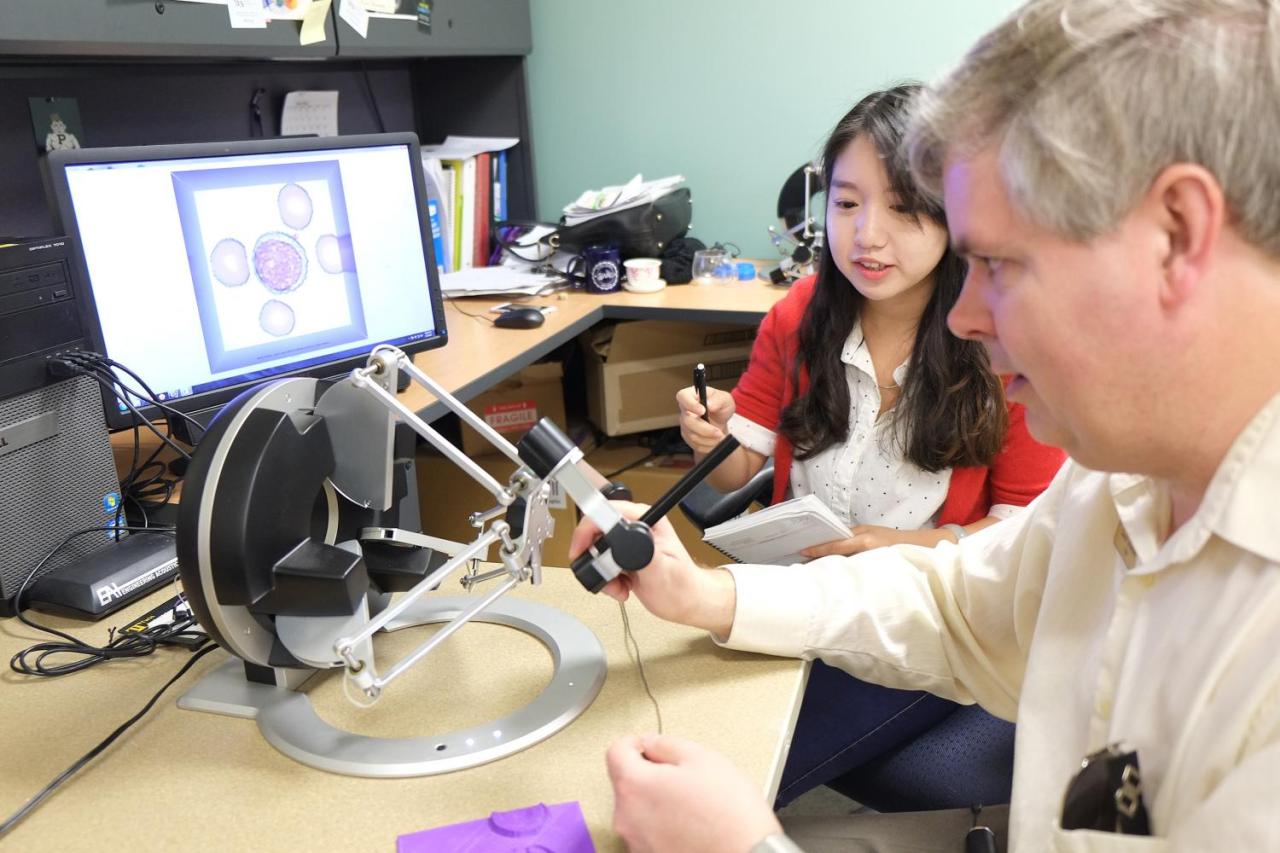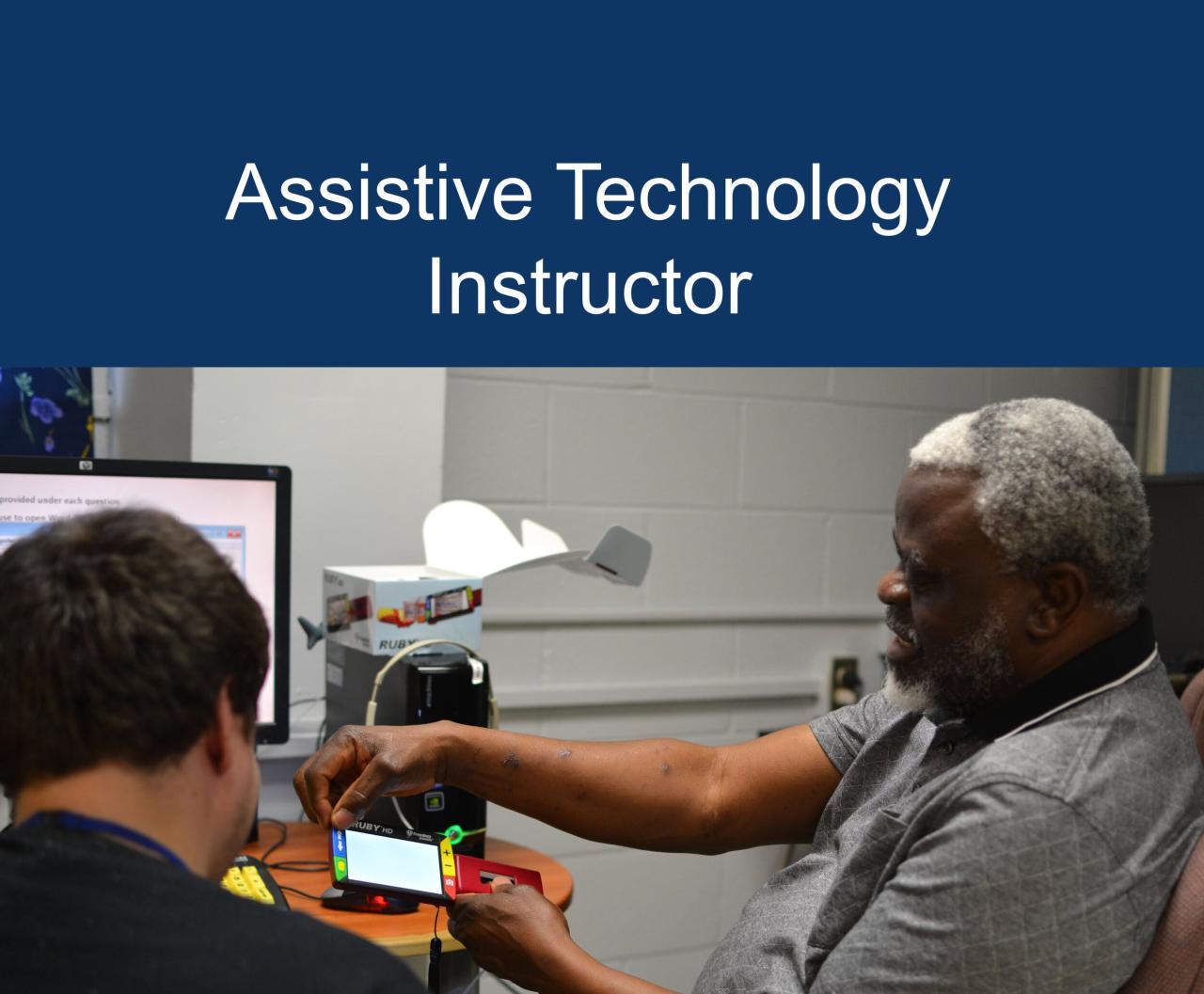Assistive Technology Specialist: Empowering Individuals
Assistive technology specialists play a crucial role in empowering individuals with disabilities by providing them with the tools and support they need to live fulfilling lives. These specialists work in […]

Assistive technology specialists play a crucial role in empowering individuals with disabilities by providing them with the tools and support they need to live fulfilling lives. These specialists work in a variety of settings, including schools, hospitals, and rehabilitation centers, to assess individual needs, recommend appropriate technologies, and provide training and ongoing support.
They bridge the gap between technology and human needs, ensuring that individuals can access information, communicate effectively, and participate fully in their communities. From mobility aids to communication devices, assistive technology encompasses a wide range of tools that can enhance independence, improve quality of life, and promote inclusion.
Role of an Assistive Technology Specialist
Assistive technology (AT) specialists play a crucial role in helping individuals with disabilities access and participate in all aspects of life. They are trained professionals who bridge the gap between technology and human needs, empowering individuals to achieve greater independence and quality of life.
Responsibilities of an Assistive Technology Specialist
AT specialists perform a variety of tasks to help individuals with disabilities. These tasks may include:
- Needs Assessment: AT specialists conduct thorough assessments to understand an individual’s specific needs, abilities, and goals. They consider factors like the nature of the disability, the individual’s environment, and their desired outcomes.
- Technology Selection: Based on the assessment, AT specialists recommend appropriate assistive technologies. This could involve a wide range of devices, software, and strategies, such as adaptive keyboards, screen readers, speech-to-text software, augmentative and alternative communication (AAC) devices, mobility aids, and environmental controls.
- Training and Support: AT specialists provide comprehensive training to individuals and their families on how to use the chosen assistive technology effectively. They offer ongoing support, troubleshooting, and adjustments as needed.
- Advocacy and Consultation: AT specialists advocate for the rights of individuals with disabilities to access appropriate assistive technology. They collaborate with other professionals, such as educators, therapists, and healthcare providers, to ensure the individual’s needs are met.
- Research and Evaluation: AT specialists stay informed about the latest advancements in assistive technology and evaluate the effectiveness of existing technologies. They contribute to the ongoing development and improvement of assistive technologies.
Diverse Work Environments
AT specialists work in a variety of settings, tailoring their expertise to meet the specific needs of the individuals they serve. Common work environments include:
- Schools: AT specialists in schools work with students with disabilities to ensure they have access to the curriculum and participate fully in classroom activities. They may assist with assistive technology for reading, writing, communication, and mobility.
- Hospitals and Rehabilitation Centers: AT specialists in healthcare settings help individuals with disabilities regain lost function and independence after an injury or illness. They may provide assistive technology for mobility, communication, daily living tasks, and cognitive support.
- Private Practices and Non-profit Organizations: AT specialists may work independently or for organizations dedicated to promoting assistive technology. They offer assessments, recommendations, and training services to individuals, families, and businesses.
- Government Agencies: AT specialists may work for government agencies that focus on disability services, providing guidance and resources to individuals and organizations.
Ethical Considerations
AT specialists are guided by ethical principles that ensure they provide competent, unbiased, and client-centered services. Key ethical considerations include:
- Confidentiality: AT specialists respect the privacy of individuals they work with, safeguarding their personal information and ensuring confidentiality.
- Competence: AT specialists maintain their knowledge and skills through ongoing professional development and stay informed about the latest advancements in assistive technology.
- Objectivity: AT specialists provide unbiased recommendations, considering the individual’s needs and goals without promoting specific products or vendors.
- Informed Consent: AT specialists obtain informed consent from individuals before providing services, ensuring they understand the benefits, risks, and alternatives associated with assistive technology.
- Beneficence and Non-maleficence: AT specialists act in the best interests of the individuals they serve, striving to benefit them while avoiding harm.
Essential Skills and Qualifications: Assistive Technology Specialist

An assistive technology specialist needs a diverse skillset to effectively meet the needs of individuals with disabilities. This involves technical proficiency, communication skills, and a deep understanding of assistive technology principles.
Technical Skills
Technical skills are essential for configuring, troubleshooting, and adapting assistive technology devices and software.
- Computer hardware and software: Proficiency in operating systems (Windows, macOS, Linux), common software applications (Microsoft Office Suite, Adobe products), and basic hardware troubleshooting.
- Assistive technology software: Familiarity with screen readers (JAWS, NVDA), screen magnifiers (ZoomText, MAGic), alternative input devices (speech recognition software, eye tracking systems), and other assistive technology tools.
- Network connectivity: Understanding network protocols, troubleshooting internet connectivity issues, and configuring assistive technology devices for network access.
- Mobile device technology: Knowledge of mobile operating systems (Android, iOS), accessibility features on smartphones and tablets, and app selection and configuration.
Soft Skills
Soft skills are equally crucial for building rapport with clients, understanding their needs, and ensuring successful implementation of assistive technology solutions.
- Communication: Excellent communication skills are essential for explaining technical concepts clearly, listening attentively to client needs, and collaborating effectively with other professionals.
- Empathy and sensitivity: The ability to understand and empathize with the challenges faced by individuals with disabilities is vital for providing personalized support and building trust.
- Problem-solving: Assistive technology specialists need strong analytical and problem-solving skills to identify challenges, explore potential solutions, and adapt technology to meet specific needs.
- Patience and adaptability: Working with individuals with diverse needs and learning styles requires patience, flexibility, and the ability to adapt approaches to suit different situations.
Educational Background and Certifications
A solid educational foundation and relevant certifications enhance an assistive technology specialist’s credibility and expertise.
- Degrees: A bachelor’s degree in a related field, such as rehabilitation technology, assistive technology, computer science, or human-computer interaction, is often preferred.
- Certifications: Professional certifications, such as the Certified Assistive Technology Professional (ATP) credential offered by the RESNA (Rehabilitation Engineering and Assistive Technology Society of North America), demonstrate specialized knowledge and skills.
- Continuing education: Ongoing professional development is essential to stay updated on emerging technologies, best practices, and evolving accessibility standards.
Assessment and Evaluation
The role of an assistive technology specialist goes beyond simply recommending devices. It involves a thorough understanding of the individual’s needs and the environment they function within. This understanding is achieved through a comprehensive assessment process, which helps determine the most appropriate assistive technology solutions.
Needs Assessment
The needs assessment process involves gathering information about the individual’s abilities, limitations, goals, and preferences. This information is used to identify the areas where assistive technology can be beneficial and to determine the specific features and functionalities required.
- Interviews: The specialist conducts in-depth interviews with the individual, their family, and other relevant stakeholders, such as teachers, therapists, or employers. This allows for a comprehensive understanding of the individual’s needs and goals.
- Observations: Observing the individual in their natural environment helps the specialist identify specific challenges and understand how assistive technology can be integrated into their daily routines.
- Assessments: Standardized assessments, such as cognitive tests, functional assessments, and sensory evaluations, are used to objectively measure the individual’s abilities and limitations.
- Environmental Analysis: The specialist assesses the individual’s environment, including their home, workplace, or school, to identify any physical or technological barriers that need to be addressed.
Assessment Tools and Techniques
A variety of assessment tools and techniques are used by assistive technology specialists. These tools are designed to gather specific information about the individual’s needs and to identify appropriate solutions.
- The Functional Independence Measure (FIM): This widely used assessment tool measures an individual’s ability to perform various daily living activities, including self-care, mobility, and communication.
- The Sensory Profile: This assessment tool evaluates an individual’s sensory processing abilities and identifies potential challenges with sensory input, which can influence the selection of assistive technology.
- The Communication Matrix: This tool helps assess an individual’s communication abilities and identify potential areas where assistive technology can enhance communication.
Ongoing Evaluation
The assessment process is not a one-time event. It is essential to conduct ongoing evaluations to ensure the effectiveness of assistive technology solutions and to address any changes in the individual’s needs.
- User Feedback: Regularly seeking feedback from the individual and their caregivers is crucial to identify any challenges, frustrations, or areas for improvement.
- Data Monitoring: Monitoring the use of assistive technology can provide valuable insights into its effectiveness and identify any patterns or trends that may indicate a need for adjustments.
- Reassessment: Periodic reassessments, especially after significant life changes or changes in the individual’s abilities, are essential to ensure that the assistive technology remains appropriate and effective.
Types of Assistive Technology

Assistive technology (AT) encompasses a wide range of tools and devices designed to enhance the capabilities of individuals with disabilities. These technologies can help individuals overcome physical, cognitive, or sensory challenges, promoting greater independence, participation, and quality of life.
Categories of Assistive Technology
Assistive technology can be broadly categorized into various types based on the specific needs they address. Each category encompasses a diverse range of technologies, each tailored to support specific aspects of daily living.
| Category | Examples | Functionalities |
|---|---|---|
| Mobility Aids | Wheelchairs, walkers, canes, scooters, adaptive vehicles | Support mobility, enhance independence in movement, and facilitate access to various environments. |
| Communication Devices | Speech-generating devices, augmentative and alternative communication (AAC) systems, communication boards, text-to-speech software | Facilitate communication, enabling individuals to express themselves, engage in conversations, and access information. |
| Sensory Aids | Hearing aids, cochlear implants, visual aids (magnifiers, CCTV), tactile displays, braille readers | Enhance sensory perception, compensate for sensory impairments, and provide access to information through alternative sensory channels. |
| Cognitive Aids | Memory aids (timers, calendars, reminder apps), organizational tools (task lists, planners), cognitive training software, assistive technology for learning disabilities | Support cognitive functions, improve memory, attention, and executive functioning, and facilitate learning and information processing. |
| Computer and Technology Aids | Screen readers, voice recognition software, alternative input devices (keyboard overlays, touchscreens), adaptive software | Enable individuals with disabilities to access and utilize computers and other technologies, promoting independence in various tasks. |
| Daily Living Aids | Adaptive utensils, dressing aids, personal care devices, environmental control systems | Simplify and enhance daily living tasks, promoting independence in self-care, household activities, and personal hygiene. |
Considerations for Technology Selection
Selecting appropriate assistive technology requires a comprehensive assessment of the individual’s needs, goals, and preferences.
A collaborative approach involving the individual, family, healthcare professionals, and assistive technology specialists is crucial.
The following considerations are paramount:
- Nature and Severity of Disability: The type and severity of the disability significantly influence the choice of technology. For example, an individual with a mobility impairment may require a wheelchair, while someone with a visual impairment may need a screen reader.
- Individual Needs and Goals: The specific needs and goals of the individual are paramount. The chosen technology should address the individual’s unique challenges and support their desired outcomes.
- Environmental Factors: The environment in which the technology will be used must be considered. Accessibility features, physical space, and other environmental factors may influence the choice of technology.
- Training and Support: The availability of training and support services is essential for successful technology adoption. Individuals need adequate training to learn how to use the technology effectively and ongoing support to address any challenges.
- Cost and Affordability: The cost of assistive technology can vary widely. It is essential to consider the individual’s financial resources and explore funding options, such as insurance coverage, government programs, or charitable organizations.
- Accessibility and Compatibility: Ensuring that the chosen technology is accessible and compatible with existing devices and systems is crucial for seamless integration.
Implementation and Training
The successful integration of assistive technology into a user’s life goes beyond simply providing the technology. It involves a comprehensive process that includes careful assessment, selection, and implementation, followed by tailored training and ongoing support. This ensures that users can effectively utilize the technology to meet their individual needs and achieve their goals.
User Training and Ongoing Support
User training is crucial for ensuring that individuals can effectively utilize assistive technology to achieve their desired outcomes. It empowers users to independently manage and operate the technology, maximizing its benefits. Ongoing support provides users with a safety net, addressing any challenges they may encounter and fostering their confidence in using the technology.
- Personalized Training Programs: Tailoring training programs to individual user needs, abilities, and goals is essential. This ensures that training is relevant and engaging, maximizing its effectiveness.
- Hands-On Experience: Providing ample opportunities for hands-on practice with the assistive technology allows users to develop proficiency and build confidence. This practical approach is particularly valuable for users who are new to the technology.
- Multi-Modal Training: Utilizing a variety of training methods, such as demonstrations, interactive exercises, and simulations, caters to different learning styles and enhances comprehension. This ensures that users can access and retain information effectively.
- Ongoing Support and Troubleshooting: Providing ongoing support through regular check-ins, troubleshooting sessions, and readily available resources ensures that users can overcome challenges and maintain proficiency in using the assistive technology. This continuous support fosters a sense of security and encourages users to utilize the technology confidently.
Emerging Trends in Assistive Technology
The field of assistive technology is constantly evolving, driven by advancements in various technologies, particularly artificial intelligence (AI) and wearables. These innovations are paving the way for more personalized, intuitive, and effective assistive solutions, impacting the role of assistive technology specialists in profound ways.
Artificial Intelligence in Assistive Technology, Assistive technology specialist
AI is revolutionizing assistive technology by enabling more intelligent and adaptive solutions. AI-powered assistive technologies can learn from user preferences and behaviors, making adjustments to provide a more personalized experience. For instance, AI algorithms can analyze user input and adjust settings for speech recognition software, making it more accurate and responsive to individual needs.
- Personalized Learning: AI-powered systems can track user progress and adapt learning materials in real-time, catering to individual learning styles and paces. This is particularly beneficial for students with learning disabilities, who may require customized instruction and support.
- Predictive Assistance: AI can anticipate user needs based on patterns and predict potential challenges, offering proactive assistance. For example, a smart wheelchair equipped with AI could navigate obstacles and avoid potential hazards before they occur.
- Enhanced Communication: AI-powered communication tools can translate spoken language into sign language, enabling seamless communication between people with hearing impairments and those who do not sign. This can facilitate inclusion and participation in social settings.
Wearable Assistive Technology
Wearable technologies are becoming increasingly popular in assistive technology, offering a range of benefits, from improved mobility to enhanced communication and cognitive support. These devices are designed to be discreet and comfortable, allowing users to seamlessly integrate assistive technology into their daily lives.
- Smart Prosthetics: Wearable sensors and AI algorithms are being integrated into prosthetic limbs, enabling more intuitive control and enhanced functionality. These advancements allow amputees to regain greater independence and participate in a wider range of activities.
- Cognitive Support: Wearable devices can track brain activity and provide real-time feedback, helping individuals with cognitive impairments improve focus, memory, and attention. These technologies can also assist with medication reminders and other daily tasks.
- Fall Detection and Emergency Response: Wearable sensors can detect falls and automatically alert emergency services, providing critical assistance for individuals at risk of falling. This can significantly reduce the risk of serious injury and improve safety for vulnerable populations.
Last Word
The field of assistive technology is constantly evolving, with advancements in artificial intelligence, wearables, and other emerging technologies. Assistive technology specialists are at the forefront of this innovation, working to ensure that individuals with disabilities have access to the latest tools and resources. Their dedication to improving lives and promoting accessibility makes them essential partners in creating a more inclusive and equitable society.
Assistive technology specialists play a crucial role in empowering individuals with disabilities by providing them with tools and strategies to enhance their independence. One such technology that can greatly benefit individuals with mobility limitations is t4 db technologies , which offers a range of assistive devices designed to simplify everyday tasks and improve overall quality of life.
By incorporating such innovative solutions into their practice, assistive technology specialists can make a significant impact on the lives of those they serve.




